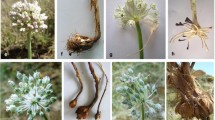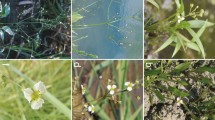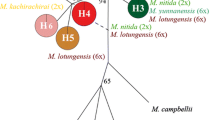Abstract
Ceratopteris thalictroides (L.) Brongn is a tetraploid fern species that contains at least three cryptic species, the south, the north and the third type. In this study we combined data from both chloroplast DNA (cpDNA) and nuclear DNA sequences of three diploid species and three cryptic species of C. thalictroides to unravel the origin of the cryptic species, particularly of the reticulate relationships among the diploid and tetraploid taxa in the genus Ceratopteris. Of the three diploid species examined, C. cornuta had cpDNA identical to that of the tetraploid third type plants, and this diploid species is a possible maternal ancestor of the tetraploid third type. Analysis of the homologue of the Arabidopsis thaliana LEAFY gene (CLFY1) identified ten alleles in the genus Ceratopteris, with six alleles found in C. thalictroides. The unrooted tree of the CLFY1 gene revealed four clusters. Each cryptic species showed fixed heterozygosity at the CLFY1 locus and had two alleles from different clusters of the CLFY1 tree. Consideration of the cpDNA sequences, CLFY1 genotypes of the cryptic species and CLFY1 gene tree in concert suggested that the cryptic species of C. thalictroides had originated through independent allopolyploidization events involving C. cornuta and two unknown hypothetical diploid species.





Similar content being viewed by others
References
Doyle JJ, Doyle JL (1987) A rapid DNA isolation procedure for small quantities of fresh leaf tissue. Phytochemistry 19:11–15
Ebihara A, Ishikawa H, Matsumoto S, Lin S, Iwatsuki K, Takamiya M, Watano Y, Ito M (2005) Nuclear DNA, chloroplast DNA, and ploidy analysis clarified biological complexity of the Vandenboschia radicans complex (Hymenophyllaceae) in Japan and adjacent areas. Am J Bot 92:1535–1547
Gastony GJ, Yatskievichi G (1992) Maternal inheritance of the chloroplast and mitochondrial genomes in Cheilantoids ferns. Am J Bot 79:716–722
Grant V (1981) Plant speciation, 2nd edn. Columbia University Press, New York
Grob GBJ, Gravendeel B, Eurlings MCM (2004) Potential phylogenetic utility of the nuclear FLORICAULA/LEAFY second intron: comparison with three chloroplast DNA regions in Amorphophallus (Araceae). Mol Phylogenet Evol 30:387–393
Hasebe M, Omori T, Nakazawa M, Sano T, Kato M, Iwatsuki K (1994) rbcL gene sequences provide evidence for the evolutionary lineages of Leptosporangiate ferns. Proc Natl Acad Sci U S A 91:5730–5734
Hasebe M, Wolf PG, Pryer KM, Ueda K, Ito M, Sano R, Gastoney G, Yokoyama J, Manhart JR, Murakami N, Crane EH, Haufler CH, Hauk WD (1995) Fern phylogeny based on rbcL nucleotide sequences. Am Fern J 85:134–181
Haufler CH, Windham MD (1991) New species of North American Cystopteris and Polypodium, with comments on their reticulate relationships. Am Fern J 81:7–23
Hauk WD, Haufler CH (1999) Isozyme variability among cryptic species of Botrychium subgenus Botrychium (Ophioglossaceae). Am J Bot 86:614–633
Hickok LG (1977) Cytological relationships between three diploid species of the ferns genus Ceratopteris. Can J Bot 55:1660–1667
Hickok LG (1979) Cytological study of intraspecific variation in Ceratopteris thalictroides. Can J Bot 57:1694–1700
Himi S, Sano R, Nishiyama T, Tanahashi T, Kato M, Ueda K, Hasebe M (2001) Evolution of MADS-Box gene induction by FLO/LFY gene. J Mol Evol 53:387–393
Hoot SB, Taylor WC (2001) The utility of nuclear ITS, a LEAFY homolog intron, and chloroplast atpB-rbcL spacer region data in phylogenetic analyses and species delimitation in Isoëtes. Am Fern J 91:166–177
Ishikawa H, Ito M, Watano Y, Kurita S (2003) Electrophoretic evidence for homoeologous chromosome pairing in the apogamous fern species Dryopteris nipponensis (Dryopteridaceae). J Plant Res 116:165–167
Kimura M (1980) A simple method for estimation of evolutionary rate of base substitutions through comparative studies of nucleotide sequences. J Mol Evol 16:110–120
Klekowski EJ Jr (1972) Genetical features of ferns as contrasted to seed plants. Ann Miss Bot Gard 59:138–151
Kumar S, Tamura K, Nei M (2004) MEGA3: integrated software for molecular evolutionary genetics analysis and sequence alignment. Brief Bioinform 5:150–163
Kurihara T, Watano Y, Takamiya M, Shimizu T (1996) Electrophoretic and cytological evidence for genetic heterogeneity and hybrid origin of Athyrium oblitescens. J Plant Res 109:29–36
Lloyd RM (1974) Systematic of the genus Ceratopteris Brongn. (Parkeriaceae) II. Taxonomy. Brittonia 26:139–160
Martin D, Rybicki E (2000) RDP: detection of recombination amongst aligned sequences. Bioinform Appl Note 16:562–563
Masuyama S (1992) Clinal variation of frond morphology and its adaptive implication in the fern Ceratopteris thalictroides in Japan. Plant Species Biol 7:87–96
Masuyama S, Watano Y (1994) Hybrid sterility between two isozymic types of the fern Ceratopteris thalictroides in Japan. J Plant Res 107:269–274
Masuyama S, Watano Y (2005) Cryptic species in the fern Ceratopteris thalictroides (L.) Brongn. (Parkeriaceae). II. Cytological characteristics of three cryptic species. Acta Phytotax Geobot 56:231–240
Masuyama S, Yatabe Y, Murakami N, Watano Y (2002) Cryptic species in the fern Ceratopteris thalictroides (L.) Brongn. (Parkeriaceae). I. Molecular analyses and crossing tests. J Plant Res 115:87–97
Nishizawa T, Watano Y (2000) Primer pairs suitable for PCR–SSCP analysis of chloroplast DNA in Angiosperms. J Phytogeogr Taxon 48:63–66
Nishimoto Y, Ohnishi O, Hasegawa M (2003) Topological incongruence between nuclear and chloroplast DNA trees suggesting hybridization in the urophyllum group of the genus Fagopyrum (Polygonaceae). Genes Genet Syst 78:139–153
Oh S, Potter D (2003) Phylogenetic utility of the second intron of LEAFY in Neillia and Stephanandra (Rosaceae) and implications for the origin of Stephanandra. Mol Phylogenet Evol 29:203–215
Oh S, Potter D (2005) Molecular phylogenetic systematics and biogeography of tribe Neillieae (Rosaceae) using DNA sequences of cpDNA, rDNA, and LEAFY. Am J Bot 92:179–192
Pal N, Pal S (1963) Studies on morphology and affinity of the Parkeriaceae. II. Sporogenesis, development of the gametophyte and cytology of Ceratopteris thalictroides. Bot Gaz Chic 124:405–412
Paris CA, Widham MD (1988) A biosystematic investigation of the Adiantum pedatum complex in Eastern North America. Syst Bot 13:240–255
Paris CA, Wagner FS, Wagner WH Jr (1989) Cryptic species, species delimitation and taxonomic practice in homosporous ferns. Am Fern J 79:46–55
Pryer KM, Haufler CH (1993) Isozymic and chromosomal evidence for the allotetraploid origin of Gymnocarpium dryopteris (Dryopteridaceae). Syst Bot 18:150–172
Raymond O, Piola F, Sanlaville-Boisson C (2002) Inference of reticulation in outcrossing allopolyploid taxa: caveats, likelihood and perspectives. Trends Ecol Evol 17:3–6
Shaw AJ, Cox CJ, Boles SB (2003) Polarity of peatmoss (Sphagnum) evolution: who says Bryophytes have no roots? Am J Bot 90:1777–1787
Small RL, Wendel JF (2002) Differential evolutionary dynamics of duplicated paralogous Adh loci in allotetraploid cotton (Gossypium). Mol Biol Evol 19:597–607
Stein DB, Barrington DS (1990) Recurring hybrid formation in a population of Polystichum x potteri: evidence from chloroplast and comparisons. Ann Miss Bot Gard 77:334–339
Swofford DL (1993) PAUP* version 4.0b10. Phylogenetic analysis using parsimony (*and other methods). Sinauer, Sunderland
Taberlet P, Gully L, Pautau G, Bouvet J (1991) Universal primers for amplification of three non-coding regions of chloroplast DNA. Plant Mol Biol 17:1105–1110
Tajima F (1993) Simple methods for testing molecular clock hypothesis. Genetics 135:599–607
Thompson JD, Gibson TJ, Plewniak F, Jeanmougin F, Higgins DG (1997) The ClustalX windows interface: flexible strategies for multiple sequence alignment aided by quality analysis tools. Nucleic Acids Res 24:4876–4882
Tryon RM, Tryon AF (1982) Fern and allied plants. Springer, Berlin Heidelberg New York
Vogel JC, Russel SJ, Rumsey FJ, Barrett JA, Gibby M (1998) Evidence of maternal transmission of chloroplast DNA in the genus Asplenium (Aspleniaceae, Pteridophyta). Bot Acta 111:247–249
Watano Y, Masuyama S (1994) Genetic differentiation in population of the polymorphic fern Ceratopteris thalictroides in Japan. J Plant Res 107:139–146
Watano Y, Kanai A, Tani N (2004) Genetic structure of hybrid zones between Pinus pumila and P. parviflora var. pentaphylla (Pinaceae) revealed by molecular hybrid index analysis. Am J Bot 9:65–72
Won H, Renner SS (2003) Horizontal gene transfer from flowering plants to Gnetum. Proc Natl Acad Sci U S A 100:10824–10829
Xiang L, Werth CH, Emery SN, McCauley DE (2000) Population-specific gender-biased hybridization between Dryopteris intermedia and D. carthusiana: evidence from chloroplast DNA. Am J Bot 87:1175–1180
Yatabe Y, Masuyama S, Darnaedi D, Murakami N (2001) Molecular systematics of the Asplenium nidus complex from Mt. Halimun National Park, Indonesia: evidence for reproductive isolation among three sympatric rbcL sequence types. Am J Bot 88:1517–1522
Acknowledgements
The authors thank the following persons who helped collect materials: Wenni S. Lestari, Pak Cecep, Pak Kiswoyo and Ms. Anti. The authors also thank Dr. Tim Utteridge (The Royal Botanic Gardens, Kew, UK) for checking and correcting the English manuscript. We also thank the two anonymous reviewers for their helpful comments. This study was supported by a Monbukagakusho (Ministry of Education, Culture, Sports, Science and Technology, Government of Japan: MEXT) scholarship to B. A., who is on the research staff of the Eka Karya Botanical Gardens, Bali, Indonesian Institute of Sciences.
Author information
Authors and Affiliations
Corresponding author
Rights and permissions
About this article
Cite this article
Adjie, B., Masuyama, S., Ishikawa, H. et al. Independent origins of tetraploid cryptic species in the fern Ceratopteris thalictroides . J Plant Res 120, 129–138 (2007). https://doi.org/10.1007/s10265-006-0032-5
Received:
Accepted:
Published:
Issue Date:
DOI: https://doi.org/10.1007/s10265-006-0032-5




